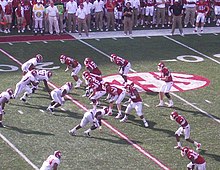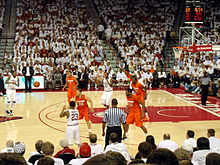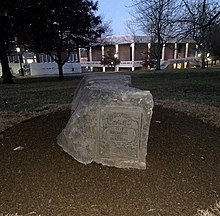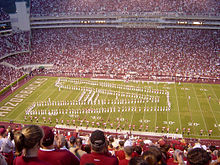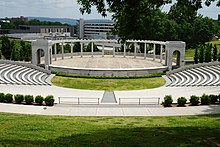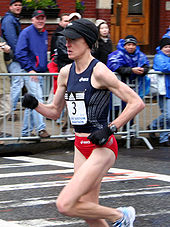University of Arkansas
The University of Arkansas was founded in 1871 on the site of a hilltop farm that overlooked the Ozark Mountains, giving it the nickname "The Hill".
[12] Old Main contains classrooms, the restored Giffels Auditorium, as well as the administrative offices of the J. William Fulbright College of Arts and Sciences.
[12] Beginning with the class of 1876, the names of students at University of Arkansas are inscribed in "Senior Walk" and wind across campus for more than four miles.
[12] One unusual structure at Arkansas is the Chi Omega Greek Theatre, a gift to the school by the sorority's national headquarters.
The largest crowd ever assembled in the theatre was for a concert by the Army Air Corps Band during World War II.
Alongside McGahee, two other African American men, Mark W. Alexander and Isom Washington, are noted as having attended Arkansas Industrial College, however no record of their enrollment has been found.
[18][19] Roy Wilkins, administrator of the NAACP, wrote in 1950 that Arkansas was the "very first of the Southern states to accept the new trend without fighting a delaying action or attempting to... limit, if not nullify, bare compliance.
"[19][20] In the fall of 1948 changes were made to the university's segregation policy, which allowed for the admittance of African American students into regular classes.
[citation needed] In 2004, the university provided resources to help support the program, establishing the John White Scholarship, Sankofa Registered Student Organization, and Ghana study abroad tour.
[23] In 2019, the University of Arkansas Board of Trustees voted to rename halls B and C of the Northwest Quad in honor of Gordon Morgan and Margaret Clark, respectively.
Stone also designed a fraternity house, now used for academic purposes, and an apartment complex named Carlson Terrace on campus, which has since been demolished.
The east end of the University of Arkansas campus is adjacent to Dickson Street, which is one of the premier entertainment districts in the state.
Kik also developed the process for parboiling rice (a major agricultural crop in the state) to increase retention of vitamins and shorten cooking time.
[12] By 1999, more than 15,000 University of Arkansas bar code readers were located in every major USPS facility, increasing the efficiency of processing 20 billion pieces of mail a year at a savings of $200 million.
"[11] During the 1980s, Professors Allen Hermann and Zhengzhi Sheng of the Department of Physics researched superconductivity, the phenomenon whereby Direct Current (DC) electricity, once started, can flow essentially forever.
[12] The Thallium-based material they discovered at Arkansas held the world's record for high temperature, 125K, for five years (1988–93) and drew international attention to the university.
[12] University of Arkansas plant pathologists conducted research in the early 1970s that led to COLLEGO, the first biological herbicide for weed control in a field crop.
Other UA scientists and students worked on the project that resulted in EPA registration of COLLEGO by Upjohn in 1982 for control of northern jointvetch in rice and soybeans.
[12] Professor Peter Ungar, a palaeoanthropologist and palaeoecologist in the Department of Environmental Dynamics, has pioneered novel methods of reconstructing the diets of extant and extinct animals.
[49] In addition to his work on hominins, Ungar has also used dental microwear to study the diets of extinct lemurs,[50] rodents,[51] bovids,[52] and suids.
[51] In 2024, Ungar was chosen to become a member of the National Academy of Sciences of the United States of America for his contributions to the study of the diets of ancient organisms.
Other Olympians have included Michael Conley, Daniel Lincoln, Graham Hood, Wallace Spearmon, Paul Donovan, and Matt Hemingway.
There are 11 varsity women sports: basketball, cross country, indoor and outdoor track, golf, gymnastics, soccer, softball, swimming & diving, tennis, and volleyball.
The gymnastics team, referred to as the GymBacks, practice at the Bev Lewis Center for Women's Athletics and compete in Barnhill Arena.
[82] In 2020, to preserve the walk, the university replaced it with high-grade monumental concrete, reinforced with steel bar, and the names were sandblasted in their original handwriting.
This tradition, which refers to the school's most popular cheer at sporting events, is said to have begun when a group of farmers attending a game began issuing hog calls to encourage a lagging Razorback football team.
In 1909, according to school lore, the head football coach Hugo Bezdek gave a speech to a large group of students at the Fayetteville train station after returning from a victory over LSU in 1909 during an undefeated season.
The Razorback, which is characterized by a ridged back and tenacious wild fighting ability, had long been associated with the backwoods of Arkansas.
[91][92] In honor of its achievement, Schola Cantorum soon after appeared on NBC TV's "Today Show" and performed for U.S. President John F. Kennedy in the White House Rose Garden.
Notable alumni in the world of sports include MLB Cy Young Award winning pitcher Cliff Lee and seven-time NBA All Star Joe Johnson.



